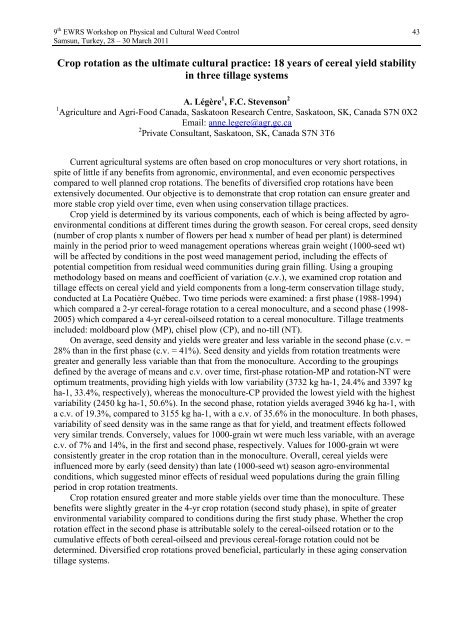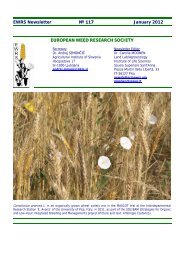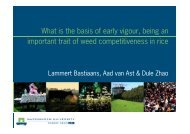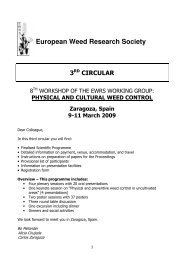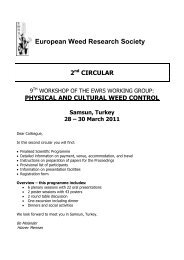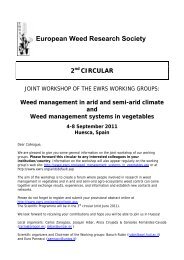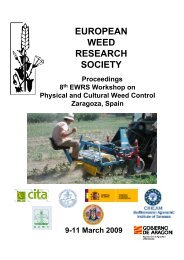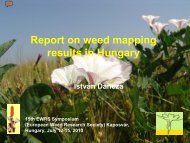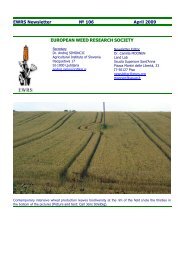Physical and Cultural Weed Control Working Group of - European ...
Physical and Cultural Weed Control Working Group of - European ...
Physical and Cultural Weed Control Working Group of - European ...
Create successful ePaper yourself
Turn your PDF publications into a flip-book with our unique Google optimized e-Paper software.
9 th EWRS Workshop on <strong>Physical</strong> <strong>and</strong> <strong>Cultural</strong> <strong>Weed</strong> <strong>Control</strong> 43<br />
Samsun, Turkey, 28 – 30 March 2011<br />
Crop rotation as the ultimate cultural practice: 18 years <strong>of</strong> cereal yield stability<br />
in three tillage systems<br />
A. Légère 1 , F.C. Stevenson 2<br />
1 Agriculture <strong>and</strong> Agri-Food Canada, Saskatoon Research Centre, Saskatoon, SK, Canada S7N 0X2<br />
Email: anne.legere@agr.gc.ca<br />
2 Private Consultant, Saskatoon, SK, Canada S7N 3T6<br />
Current agricultural systems are <strong>of</strong>ten based on crop monocultures or very short rotations, in<br />
spite <strong>of</strong> little if any benefits from agronomic, environmental, <strong>and</strong> even economic perspectives<br />
compared to well planned crop rotations. The benefits <strong>of</strong> diversified crop rotations have been<br />
extensively documented. Our objective is to demonstrate that crop rotation can ensure greater <strong>and</strong><br />
more stable crop yield over time, even when using conservation tillage practices.<br />
Crop yield is determined by its various components, each <strong>of</strong> which is being affected by agroenvironmental<br />
conditions at different times during the growth season. For cereal crops, seed density<br />
(number <strong>of</strong> crop plants x number <strong>of</strong> flowers per head x number <strong>of</strong> head per plant) is determined<br />
mainly in the period prior to weed management operations whereas grain weight (1000-seed wt)<br />
will be affected by conditions in the post weed management period, including the effects <strong>of</strong><br />
potential competition from residual weed communities during grain filling. Using a grouping<br />
methodology based on means <strong>and</strong> coefficient <strong>of</strong> variation (c.v.), we examined crop rotation <strong>and</strong><br />
tillage effects on cereal yield <strong>and</strong> yield components from a long-term conservation tillage study,<br />
conducted at La Pocatière Québec. Two time periods were examined: a first phase (1988-1994)<br />
which compared a 2-yr cereal-forage rotation to a cereal monoculture, <strong>and</strong> a second phase (1998-<br />
2005) which compared a 4-yr cereal-oilseed rotation to a cereal monoculture. Tillage treatments<br />
included: moldboard plow (MP), chisel plow (CP), <strong>and</strong> no-till (NT).<br />
On average, seed density <strong>and</strong> yields were greater <strong>and</strong> less variable in the second phase (c.v. =<br />
28% than in the first phase (c.v. = 41%). Seed density <strong>and</strong> yields from rotation treatments were<br />
greater <strong>and</strong> generally less variable than that from the monoculture. According to the groupings<br />
defined by the average <strong>of</strong> means <strong>and</strong> c.v. over time, first-phase rotation-MP <strong>and</strong> rotation-NT were<br />
optimum treatments, providing high yields with low variability (3732 kg ha-1, 24.4% <strong>and</strong> 3397 kg<br />
ha-1, 33.4%, respectively), whereas the monoculture-CP provided the lowest yield with the highest<br />
variability (2450 kg ha-1, 50.6%). In the second phase, rotation yields averaged 3946 kg ha-1, with<br />
a c.v. <strong>of</strong> 19.3%, compared to 3155 kg ha-1, with a c.v. <strong>of</strong> 35.6% in the monoculture. In both phases,<br />
variability <strong>of</strong> seed density was in the same range as that for yield, <strong>and</strong> treatment effects followed<br />
very similar trends. Conversely, values for 1000-grain wt were much less variable, with an average<br />
c.v. <strong>of</strong> 7% <strong>and</strong> 14%, in the first <strong>and</strong> second phase, respectively. Values for 1000-grain wt were<br />
consistently greater in the crop rotation than in the monoculture. Overall, cereal yields were<br />
influenced more by early (seed density) than late (1000-seed wt) season agro-environmental<br />
conditions, which suggested minor effects <strong>of</strong> residual weed populations during the grain filling<br />
period in crop rotation treatments.<br />
Crop rotation ensured greater <strong>and</strong> more stable yields over time than the monoculture. These<br />
benefits were slightly greater in the 4-yr crop rotation (second study phase), in spite <strong>of</strong> greater<br />
environmental variability compared to conditions during the first study phase. Whether the crop<br />
rotation effect in the second phase is attributable solely to the cereal-oilseed rotation or to the<br />
cumulative effects <strong>of</strong> both cereal-oilseed <strong>and</strong> previous cereal-forage rotation could not be<br />
determined. Diversified crop rotations proved beneficial, particularly in these aging conservation<br />
tillage systems.


